Do you have a question about the ALIBI ALI-QVR3104H and is the answer not in the manual?
Disclaims liability for unauthorized accessories and advises compliance with surveillance laws.
Details the on-screen keyboard layouts for inputting data like passwords or IP addresses.
Explains how to use a standard 3-button USB mouse for navigation and interaction with the recorder.
Guides through the initial configuration of the recorder upon first power-on.
Describes how to access the main menu interface by right-clicking on the Live View screen.
Covers adding IP cameras, configuring analog cameras, and PTZ controls.
Configures analog channels to function as IP camera channels for network camera integration.
Explains how to add IP cameras directly from the Live View screen interface.
Details the process for activating Alibi IP cameras before they can be used.
Provides an alternative method for adding IP cameras via the Camera Management menu.
Covers OSD, image settings, motion detection, and privacy mask for analog cameras.
Configures On-Screen Display labels for camera identification and timestamps.
Adjusts image quality parameters like brightness, contrast, and saturation for cameras.
Covers the configuration of PTZ features for compatible cameras.
Explains how to configure motion detection zones and sensitivity for cameras.
Allows blocking specific areas of the video image for privacy considerations.
Configures detection for when a camera lens is covered or obscured.
Sets up alarms and actions for when a video signal is lost.
Enables configuration of Video Content Analytics features for supported cameras.
Analyzes video quality and sets thresholds for image issues.
Allows manual checks of video quality settings and diagnostics.
Manages internal and network storage, including initialization and configuration.
Checks the operational status of installed HDDs to ensure normal functioning.
Details adding network storage devices like NAS or IP SAN.
Covers initial setup and configuration of the Hard Disk Drive.
Assigns HDDs to groups for camera recordings, requiring a QVR reboot.
Enables saving video and event data to cloud servers like OneDrive or Dropbox.
Monitors HDD health using S.M.A.R.T. data and bad sector detection.
Detects human faces in the camera's field of view and triggers actions.
Detects objects crossing a virtual line and triggers actions based on direction.
Detects objects entering a defined virtual region and triggers alarms.
Detects objects entering a predefined virtual region and triggers alerts.
Detects objects leaving a predefined virtual region and triggers alerts.
Detects unattended objects left in a defined area, triggering alarms.
Detects when an object is removed from a predefined area, triggering alerts.
Detects abnormal sound levels (increase/decrease) in the surveillance area.
Senses image blur caused by lens defocus, triggering alerts.
Detects changes in the surveillance environment caused by external factors.
Detects heat signatures from people or animals, triggering infrared alarms.
Allows quick analysis of video data generated from VCA analysis.
Analyzes suspicious behavior based on VCA data, triggering specific linkage actions.
Covers essential procedures for powering on, shutting down, and rebooting the QVR system.
Details the steps for properly powering on the QVR unit.
Provides instructions for safely shutting down the QVR system.
Explains how to restart the QVR system through the shutdown menu.
Configures the output resolution for connected VGA and HDMI monitors.
Describes the context menu that appears when right-clicking on the Live View screen.
Explains the support for multiple monitors via HDMI, VGA, and CVBS outputs.
Configures how the menu interface is displayed across different monitors.
Details mouse operations for interacting with the Live View display.
Explains the meaning of icons displayed in the Live View for status indicators.
Provides quick access to common functions via icons at the top or bottom of the frame.
Customizes Live View display aspects like screen split, placement, and dwell time.
Reduces bandwidth for remote viewing without affecting image quality.
Sets up parameters for continuous and event recording for each camera channel.
Configures main and sub-stream recording parameters like resolution and bitrate.
Allows configuring special recording schedules for holidays that override normal schedules.
Defines schedules for automatically starting and stopping recording at preset times.
Enables or disables advanced features like H.264+/H.265+ for analog cameras.
Sets up motion detection to record only in specific areas of the video image.
Initiates and cancels manual recording operations outside of scheduled or event-based recording.
Assigns HDDs to groups for camera recordings, requiring a QVR reboot.
Locks recorded files or sets HDD property to Read-only to prevent overwriting.
Allows reviewing recorded video files from cameras.
Plays back recordings from a specific channel in Live View mode.
Opens the playback interface to select and play recorded video by channel.
Plays back video files recorded within a specified time duration.
Searches and plays back record files based on event types like motion or alarm.
Uses tags to identify, find, and replay video clips.
Plays back record files associated with channels after searching system logs.
Bypasses unimportant information by speeding up video without motion or VCA events.
Divides video files into segments for playback based on split-screen configuration.
Plays back video files saved on external devices like USB drives.
Allows playing video files frame by frame for detailed image checking.
Enables zooming in on specific areas of the video image during playback.
Allows exporting specific video clips to USB storage devices.
Exports video clips by searching for them based on specific criteria.
Searches for and exports video recordings triggered by events like motion detection.
Allows backing up segments of video recordings during the playback process.
Connects the QVR RS-485 interface to PTZ cameras by sensing communication format and protocol.
Provides quick access to PTZ features for camera control.
Details the items available in the PTZ Live View menu for camera control.
Configures preset camera positions, patrol routes, and movement patterns.
Sets specific camera positions that the PTZ camera can be moved to.
Moves the camera to a pre-configured position by calling a saved preset.
Sets up patrol routes by defining a sequence of key points (presets) and dwell times.
Executes a pre-configured patrol route on the PTZ camera.
Records and replays PTZ camera movements as patterns.
Executes a recorded pattern to move the PTZ camera.
Enables horizontal scanning within a predefined range for PTZ cameras.
Executes a predefined linear scan on the PTZ camera.
Moves the PTZ camera to a home or park position after a period of inactivity.
Creates new user accounts with specific permissions for system access.
Removes existing user accounts from the system.
Modifies existing user account details and permissions.
Sets up basic network parameters like IP address, subnet mask, and DNS.
Configures Dynamic DNS for remote access to the QVR from outside the local network.
Sets up an NTP server for accurate system date and time synchronization.
Configures multicast function for connecting more than 64 cameras.
Configures the RTSP port for controlling streaming media servers.
Changes the default server and HTTP ports for network access.
Sets up email notifications for alarm events and system status changes.
Enables Universal Plug and Play for seamless network device discovery and connection.
Prepares new or replaced HDDs for use by the recorder by initializing them.
Connects external NAS or IP SAN devices for additional storage.
Adds NAS or IP SAN storage devices to the QVR system.
Allocates storage space on HDDs for individual cameras or groups of cameras.
Assigns properties like redundancy or read-only to HDDs for data protection.
Performs maintenance tasks on HDDs, including status reporting.
Enables daily reporting of the HDD status for monitoring.
Displays system status reports for the QVR, cameras, network, and HDDs.
Provides access to system logs, including alarms, exceptions, and operations.
Searches system logs for specific entries based on criteria like time and type.
Exports system log information to a USB device in a readable text format.
Exports and imports the QVR configuration to restore settings.
Updates the QVR firmware via USB, Alibi Connect cloud, or FTP server.
Restores the QVR configuration to its original factory default settings.
Monitors network traffic, tests network delay, and exports network packets.
Displays real-time network traffic information like linking status and rates.
Tests network delay and packet loss by pinging a destination address.
Exports captured network data packets to a USB device for analysis.
Checks the network status and allows adjustment of network parameters.
Views real-time network status, including bandwidth usage.
Details the process for logging into the QVR from a remote computer.
Describes the remote Live View interface, including screen layouts and controls.
Allows reviewing recorded video remotely and downloading it to a local computer.
Enables viewing and changing QVR configuration remotely.
Sets Live View parameters and storage locations for remote access.
Accesses and reviews QVR logs remotely.
Displays device model, serial number, and firmware versions installed in the QVR.
Records high-res video locally and transmits lower-res stream over network.
Acronym for Hard Disk Drive, a storage medium for digital data.
Dynamic Host Configuration Protocol for obtaining network configuration.
Hypertext Transfer Protocol for transferring information between servers and browsers.
Point-to-Point Protocol over Ethernet for encapsulating PPP frames inside Ethernet.
Dynamic DNS service to update IP address in real-time for domain name servers.
A DVR that combines DVR and NVR functionalities.
Network Time Protocol for synchronizing computer clocks over a network.
Analog television standard used in US and Japan.
Digital Video Recorder for centralized management and storage.
Analog television standard used in broadcast systems.
Pan, Tilt, Zoom camera controls.
Universal Serial Bus for interfacing devices to a host computer.
Possible reasons for beeping: no HDD, uninitialized HDD, or HDD error.
Troubleshooting steps for unresponsive IR remote control operation.
Checks recording schedule, motion detection area, and channel triggers.
Suggests checking USB device compatibility and referring to the company website.
Troubleshooting steps for a non-functional remote control, including checking batteries and device ID.
Disclaims liability for unauthorized accessories and advises compliance with surveillance laws.
Details the on-screen keyboard layouts for inputting data like passwords or IP addresses.
Explains how to use a standard 3-button USB mouse for navigation and interaction with the recorder.
Guides through the initial configuration of the recorder upon first power-on.
Describes how to access the main menu interface by right-clicking on the Live View screen.
Covers adding IP cameras, configuring analog cameras, and PTZ controls.
Configures analog channels to function as IP camera channels for network camera integration.
Explains how to add IP cameras directly from the Live View screen interface.
Details the process for activating Alibi IP cameras before they can be used.
Provides an alternative method for adding IP cameras via the Camera Management menu.
Covers OSD, image settings, motion detection, and privacy mask for analog cameras.
Configures On-Screen Display labels for camera identification and timestamps.
Adjusts image quality parameters like brightness, contrast, and saturation for cameras.
Covers the configuration of PTZ features for compatible cameras.
Explains how to configure motion detection zones and sensitivity for cameras.
Allows blocking specific areas of the video image for privacy considerations.
Configures detection for when a camera lens is covered or obscured.
Sets up alarms and actions for when a video signal is lost.
Enables configuration of Video Content Analytics features for supported cameras.
Analyzes video quality and sets thresholds for image issues.
Allows manual checks of video quality settings and diagnostics.
Manages internal and network storage, including initialization and configuration.
Checks the operational status of installed HDDs to ensure normal functioning.
Details adding network storage devices like NAS or IP SAN.
Covers initial setup and configuration of the Hard Disk Drive.
Assigns HDDs to groups for camera recordings, requiring a QVR reboot.
Enables saving video and event data to cloud servers like OneDrive or Dropbox.
Monitors HDD health using S.M.A.R.T. data and bad sector detection.
Detects human faces in the camera's field of view and triggers actions.
Detects objects crossing a virtual line and triggers actions based on direction.
Detects objects entering a defined virtual region and triggers alarms.
Detects objects entering a predefined virtual region and triggers alerts.
Detects objects leaving a predefined virtual region and triggers alerts.
Detects unattended objects left in a defined area, triggering alarms.
Detects when an object is removed from a predefined area, triggering alerts.
Detects abnormal sound levels (increase/decrease) in the surveillance area.
Senses image blur caused by lens defocus, triggering alerts.
Detects changes in the surveillance environment caused by external factors.
Detects heat signatures from people or animals, triggering infrared alarms.
Allows quick analysis of video data generated from VCA analysis.
Analyzes suspicious behavior based on VCA data, triggering specific linkage actions.
Covers essential procedures for powering on, shutting down, and rebooting the QVR system.
Details the steps for properly powering on the QVR unit.
Provides instructions for safely shutting down the QVR system.
Explains how to restart the QVR system through the shutdown menu.
Configures the output resolution for connected VGA and HDMI monitors.
Describes the context menu that appears when right-clicking on the Live View screen.
Explains the support for multiple monitors via HDMI, VGA, and CVBS outputs.
Configures how the menu interface is displayed across different monitors.
Details mouse operations for interacting with the Live View display.
Explains the meaning of icons displayed in the Live View for status indicators.
Provides quick access to common functions via icons at the top or bottom of the frame.
Customizes Live View display aspects like screen split, placement, and dwell time.
Reduces bandwidth for remote viewing without affecting image quality.
Sets up parameters for continuous and event recording for each camera channel.
Configures main and sub-stream recording parameters like resolution and bitrate.
Allows configuring special recording schedules for holidays that override normal schedules.
Defines schedules for automatically starting and stopping recording at preset times.
Enables or disables advanced features like H.264+/H.265+ for analog cameras.
Sets up motion detection to record only in specific areas of the video image.
Initiates and cancels manual recording operations outside of scheduled or event-based recording.
Assigns HDDs to groups for camera recordings, requiring a QVR reboot.
Locks recorded files or sets HDD property to Read-only to prevent overwriting.
Allows reviewing recorded video files from cameras.
Plays back recordings from a specific channel in Live View mode.
Opens the playback interface to select and play recorded video by channel.
Plays back video files recorded within a specified time duration.
Searches and plays back record files based on event types like motion or alarm.
Uses tags to identify, find, and replay video clips.
Plays back record files associated with channels after searching system logs.
Bypasses unimportant information by speeding up video without motion or VCA events.
Divides video files into segments for playback based on split-screen configuration.
Plays back video files saved on external devices like USB drives.
Allows playing video files frame by frame for detailed image checking.
Enables zooming in on specific areas of the video image during playback.
Allows exporting specific video clips to USB storage devices.
Exports video clips by searching for them based on specific criteria.
Searches for and exports video recordings triggered by events like motion detection.
Allows backing up segments of video recordings during the playback process.
Connects the QVR RS-485 interface to PTZ cameras by sensing communication format and protocol.
Provides quick access to PTZ features for camera control.
Details the items available in the PTZ Live View menu for camera control.
Configures preset camera positions, patrol routes, and movement patterns.
Sets specific camera positions that the PTZ camera can be moved to.
Moves the camera to a pre-configured position by calling a saved preset.
Sets up patrol routes by defining a sequence of key points (presets) and dwell times.
Executes a pre-configured patrol route on the PTZ camera.
Records and replays PTZ camera movements as patterns.
Executes a recorded pattern to move the PTZ camera.
Enables horizontal scanning within a predefined range for PTZ cameras.
Executes a predefined linear scan on the PTZ camera.
Moves the PTZ camera to a home or park position after a period of inactivity.
Creates new user accounts with specific permissions for system access.
Removes existing user accounts from the system.
Modifies existing user account details and permissions.
Sets up basic network parameters like IP address, subnet mask, and DNS.
Configures Dynamic DNS for remote access to the QVR from outside the local network.
Sets up an NTP server for accurate system date and time synchronization.
Configures multicast function for connecting more than 64 cameras.
Configures the RTSP port for controlling streaming media servers.
Changes the default server and HTTP ports for network access.
Sets up email notifications for alarm events and system status changes.
Enables Universal Plug and Play for seamless network device discovery and connection.
Prepares new or replaced HDDs for use by the recorder by initializing them.
Connects external NAS or IP SAN devices for additional storage.
Adds NAS or IP SAN storage devices to the QVR system.
Allocates storage space on HDDs for individual cameras or groups of cameras.
Assigns properties like redundancy or read-only to HDDs for data protection.
Performs maintenance tasks on HDDs, including status reporting.
Enables daily reporting of the HDD status for monitoring.
Displays system status reports for the QVR, cameras, network, and HDDs.
Provides access to system logs, including alarms, exceptions, and operations.
Searches system logs for specific entries based on criteria like time and type.
Exports system log information to a USB device in a readable text format.
Exports and imports the QVR configuration to restore settings.
Updates the QVR firmware via USB, Alibi Connect cloud, or FTP server.
Restores the QVR configuration to its original factory default settings.
Monitors network traffic, tests network delay, and exports network packets.
Displays real-time network traffic information like linking status and rates.
Tests network delay and packet loss by pinging a destination address.
Exports captured network data packets to a USB device for analysis.
Checks the network status and allows adjustment of network parameters.
Views real-time network status, including bandwidth usage.
Details the process for logging into the QVR from a remote computer.
Describes the remote Live View interface, including screen layouts and controls.
Allows reviewing recorded video remotely and downloading it to a local computer.
Enables viewing and changing QVR configuration remotely.
Sets Live View parameters and storage locations for remote access.
Accesses and reviews QVR logs remotely.
Displays device model, serial number, and firmware versions installed in the QVR.
Records high-res video locally and transmits lower-res stream over network.
Acronym for Hard Disk Drive, a storage medium for digital data.
Dynamic Host Configuration Protocol for obtaining network configuration.
Hypertext Transfer Protocol for transferring information between servers and browsers.
Point-to-Point Protocol over Ethernet for encapsulating PPP frames inside Ethernet.
Dynamic DNS service to update IP address in real-time for domain name servers.
A DVR that combines DVR and NVR functionalities.
Network Time Protocol for synchronizing computer clocks over a network.
Analog television standard used in US and Japan.
Digital Video Recorder for centralized management and storage.
Analog television standard used in broadcast systems.
Pan, Tilt, Zoom camera controls.
Universal Serial Bus for interfacing devices to a host computer.
Possible reasons for beeping: no HDD, uninitialized HDD, or HDD error.
Troubleshooting steps for unresponsive IR remote control operation.
Checks recording schedule, motion detection area, and channel triggers.
Suggests checking USB device compatibility and referring to the company website.
Troubleshooting steps for a non-functional remote control, including checking batteries and device ID.
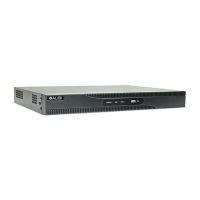





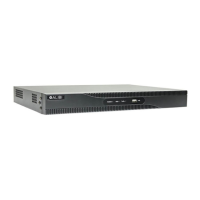


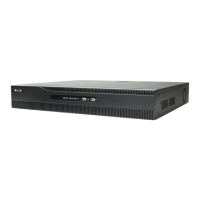
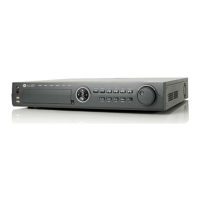
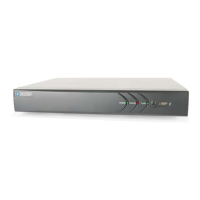
